|
Delco-Remy in WWII
Delco-Remy WWII Aircraft Products
Delco-Remy WWII Vehicle Products
Delco-Remy and LST-393
Delco-Remy WWII Kings Mills Plant
Delco-Remy WWII Antioch Foundry
Delco-Remy WWII
Stationary Engine Products
Delco-Remy WWII
Electrical Components for the Reo and Federal Truck, 20-Ton, 6x4
Delco-Remy
Training Manuals for Aircraft Components
Delco-Remy in
World War Two
World War Two
Products and Product Applications
Marine Equipment for
Boats, Ships and Landing Craft
This page updated
5-30-2025.
Author's note: This page was added to the website in March
2016, with an update in March 2018. The original information from
2016 and 2018 was based on information noted in "Our War
Job," published by Delco-Remy in 1944. Since 2018, I have learned
considerably more from other research of other World War Two-era
companies about the engines and ships in which Delco-Remy products were
utilized. The new Summary Table gives an overview of the
engines, along with their associated watercraft, in which Delco-Remy
parts were installed in during the war. Tables 1-6 give more
specific information on the different marine engines, and the boats and ships
in which they were used. The information below shows Delco-Remy electrical equipment
along with supercharger blowers, pistons and other equipment were used
at the forefront of naval warfare during World War Two. Delco-Remy
was in important factor in the winning of the naval war. DDJ
4-22-2020
Delco-Remy Marine Equipment in World War
Two from "Our War Job:" Thirty-eight models of
generators, 11 models of regulators, 61 models of starting motors, eight
models of ignition distributors and seven models of ignition coils;
along with
supercharger blowers for marine diesels, pistons for marine
diesels with diameter of pistons ranging from 4 to 17 inches in
diameter, diesel engine intake air pre-heaters, diesel engine fuel
pre-heaters, diesel engine governor castings, and propeller pitch
controls for sub-chasers and Landing Craft, Infantry (LCI) landing craft.
|
Summary Table -
Types of World War Two Delco-Remy-Equipped Marine Engines |
| Engine type |
Total Number of Engines
built |
Delco-Remy
Equipment |
Applications |
|
Packard 4M2500 Marine Engine |
12,700 |
Starters and generators |
Various Motor Torpedo and Rescue Boats |
| Hall-Scott Defender Marine Engine |
6,514 |
Starters, generators, distributors, and coils |
Various British Gun Boats and 63-foot Rescue Boats |
| Hall-Scott / Hudson
Motor Car Company Invader Marine Engine |
5,692 |
Starters, generators, distributors, and coils |
Landing Craft types LCP(L), LCP(R), LCV, LCVP, and 36-foot and
42-foot Rescue Boats |
|
Kermath Sea-Raider 6 Marine Engine |
? |
Starters, generators, distributors, and coils |
42-foot Rescue Boats |
|
Kermath Sea-Raider Special 12 Marine Engine |
? |
Starters, generators, voltage regulators, distributors, and coils |
104-foot Rescue Boats |
| Gray
Marine 64HN9/Detroit Diesel 6-71 Marine Engine |
57,189 |
Blowers, starters, generators, and regulators |
Landing craft types LCP(L), LCP(R), LCV, LCVP, LCM, LCI,
LCT and LSTs |
|
Cleveland Diesel Engines, various sizes |
5,444 |
Pistons |
Submarines, Destroyer Escorts, Freighters and Minesweepers |
|
Electro-Motive 12-567 Marine Engine |
1,050 |
Starters and pistons |
|
|
Total |
88,769 |
|
|
Packard 4M2500 Marine Engine: One prominent and important use of Delco-Remy
electrical equipment was for the Packard 4M2500 Marine Engine that was
used on several types of high-speed watercraft. The most famous of
these boats was the American PT boat built by Higgins and Elco. Each 4M2500 engine was equipped with
a Delco-Remy starter, generator and voltage regulator.
There were 12,700 Packard 4M2500 marine
engines built during World War Two. For the small, fast PT and
rescue boats of the war, the 4M2500 was the preferred engine. This
was because it could produce up to 1,500 hp in the later variants.
It was the most powerful of the gasoline powered engines of its type.
Table 1 below shows the known uses. While Table 1 shows less than
half of the engines being utilized in the known applications, at the
start of World War Two, there were not enough of them to meet all of the
demand. Production could not keep up. Therefore, several
other types of engines were used in some of the same applications as
other tables below will show. The substitute engines also had
Delco-Remy components. No matter the which engine powered a fast
motor torpedo or rescue boat, Delco-Remy was onboard.
|
Table 1 -
Different Boat Types using the Packard 4M2500 Marine Engine |
|
Boat Type |
Number of Boats |
Engines per Boat |
Total Number of Engines |
Comments |
|
American-built Patrol Torpedo Boats (PT) |
741 |
3 |
2,223 |
506
went to the U.S., 146 to the U.K. and 93 to the U.S.S.R.
|
|
Canadian-built Patrol Torpedo Boats (PT) |
4 |
3 |
12 |
These
were for U.S. Navy. |
|
British-built Motor Torpedo Boats (MTB) |
44 |
3 |
132 |
|
|
British-built Motor Gun Boats (MGB) |
228 |
3 |
684 |
|
|
American-built Patrol 63-foot Crash Rescue Boats |
16 |
2 |
32 |
|
|
American-built Patrol 85-foot Rescue Boats |
140 |
2 |
280 |
|
|
American-built Patrol 104-foot Rescue Boats |
50 |
2 |
100 |
Estimated number. The 104-foot rescue boats were also
powered by Kermath and Hall-Scott engines. |
|
Totals |
1,224 |
|
3,463 |
|
|
The UK and Canada received 4,686
Packard engines during the war through either direct purchase or Lend-Lease. With 12,700 total engines built,
this left 8,014 for spares for US and USSR applications in PT
boats and OEM engines in the various rescue boats built for both
the Army Air Corps and the US Navy. |
P-T 305 is only World War Two veteran Higgins-built PT boat still in
existence. It has been restored to operating condition and
currently gives rides and tours. The three Packard 4M2500 engines
all have Delco-Remy electrical equipment on them.

Higgins Industries of New Orleans, LA built
201 PT boats during WWII, including PT-305 that served in the
Mediterranean Theater of Operations. PT-305 participated in 77
combat missions, sank three boats, and supported the Allied landings at
Elba and Southern France. The location of PT-305's boat house on
Lake Pontchartrain on the north side of New Orleans is four miles from
where she was manufactured in 1943.
Author's photo added 3-29-2018.

This is the starboard Packard 4M2500 engine in
PT-305. The Delco-Remy cranking motor and DC generator are plainly
visible from the deck. Author's photo added 3-31-2018. The
handle protruding from the rear of the engine is the transmission shift
lever. The transmission had three positions: forward,
neutral, and reverse. Each engine had to be manually shifted by
the mechanic in the engine room while the engine speed was controlled by
the helmsmen. Author's photo added 3-29-2018.

The D-R DC generator on the starboard engine.
Author's photo added 3-29-2018.

Visitors are not allowed in the engine room.
This photo and the following photo were taken from the deck to show the
D-R tag on the cranking motor.
Author's photo added 3-29-2018.

The name Delco-Remy can be read, but not the
rest of the information. The rectangular data plate most likely
indicates this was built at the DR WWII motor plant in Kings Mill, OH.
Author's photo added 3-29-2018.

The DC generator can just be seen under the
exhaust pipe on the port engine. Author's photo added 3-29-2018.

The generator and D-R tag can be seen a little
better in this enlargement. Author's photo added 3-29-2018.
63-foot
Rescue Boat P-619:

This 63-foot rescue boat built by the Miami Shipbuilding Company in
December 1943 is now owned by Randy Cunningham of British Columbia.
It is powered by two Packard 4M2500 marine engines. Due to the
shortage of the Packard 4M2500, some of these
boats were powered by the Hall-Scott Defender marine engine. They
had Delco-Remy 1111597 ignition assemblies. See the Hall-Scott
Defender section and Table 2 below. Photo added 4-23-2020.

P-520 is an 85-foot Army Air Force rescue boat. It was built in
1944 by the Wilmington Boat Works of Wilmington, CA and is powered by
two Packard 4M2500 marine engines. Some of these boats were
powered by the Hall-Scott Defender marine engine as shown in Table 2 below. Photo added
4-23-2020.

This drawing for an 85-foot rescue boat
calls for two Packard 4M2500 engines. Each
engine had a Delco-Remy starter and DC generator. Drawing added
4-23-2020.

Here is an exploded view of the 85-foot
Crash Rescue Boat that was powered by two Packard marine or Hall-Scott
Defender engines.
It didn't matter which engines were used, because both had Delco-Remy
electrical equipment installed. Author's photo at the National Museum of the United States Air Force.
Author's photo added 4-23-2020.

This photo of the model shows the engine
room with the drive shaft oriented towards the front of the boat and
then being directed towards the propeller at the stern through a
transfer case. There are two engines in the display, but my photo only
captured one. Author's photo at the National Museum of the United
States Air Force added 4-23-2020.
Packard
4M2500 Marine Engines with Delco-Remy DC generators and starters:
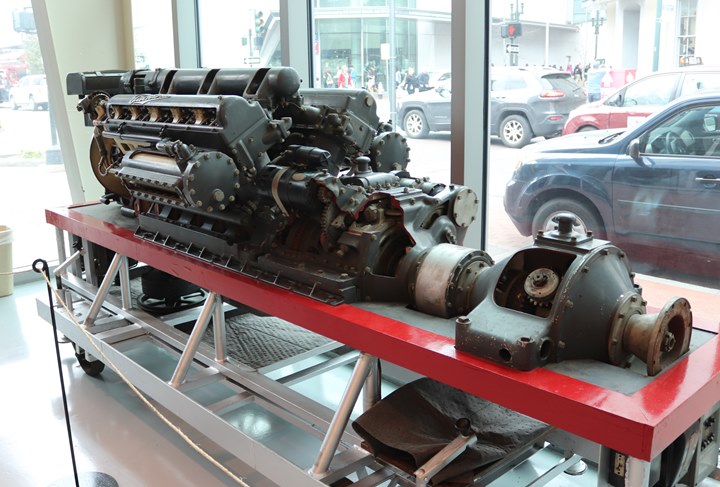
The first display a visitor encounters
when entering John E. Kushner Restoration Pavilion at the National WWII
Museum in New Orleans, LA is this cutaway of a Packard 4M2500 marine
engine. The Delco-Remy cranking motor on the engine is prominently
visible from the entrance of the building. In September 2017, the
National WWII Museum was ranked the number two museum in both the USA and
the world by TripAdvisor Traveler's Choice. Visitors from around
the world see the Packard cutaway with its prominently displayed D-R
cranking motor. Author's photo added 3-29-2018.
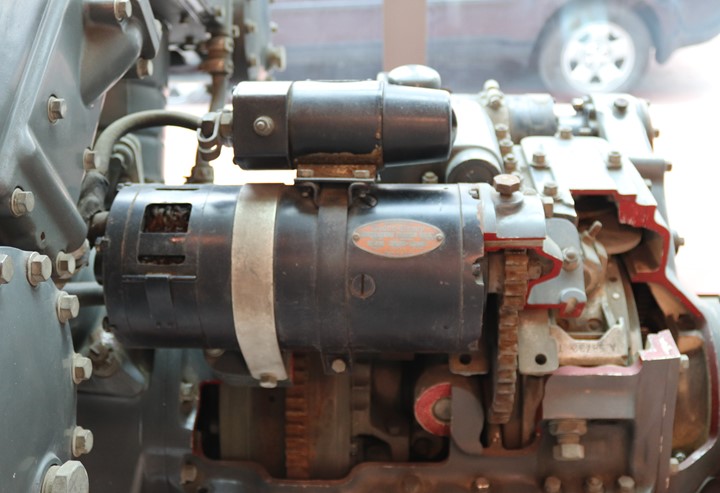
All the visitors that view the engine at one
of the world's most visited museums will see the Delco-Remy naval
starter and its distinctive oval D-R tag. Author's photo added
3-29-2018.
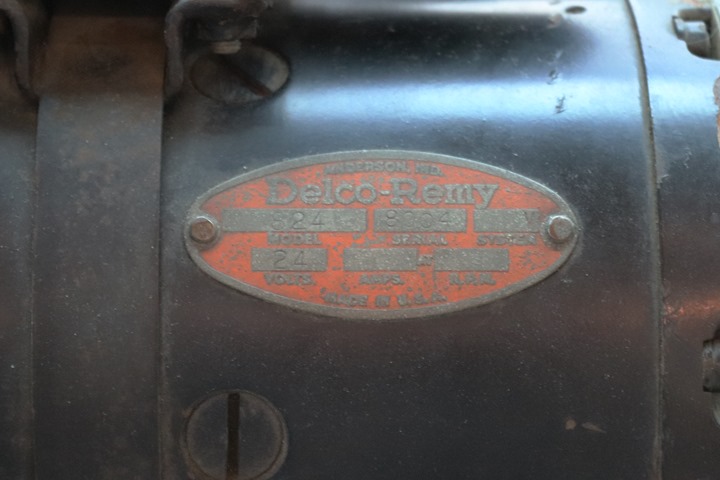
The starter is model 824 and has serial number
8904. Author's photo added 3-29-2018.
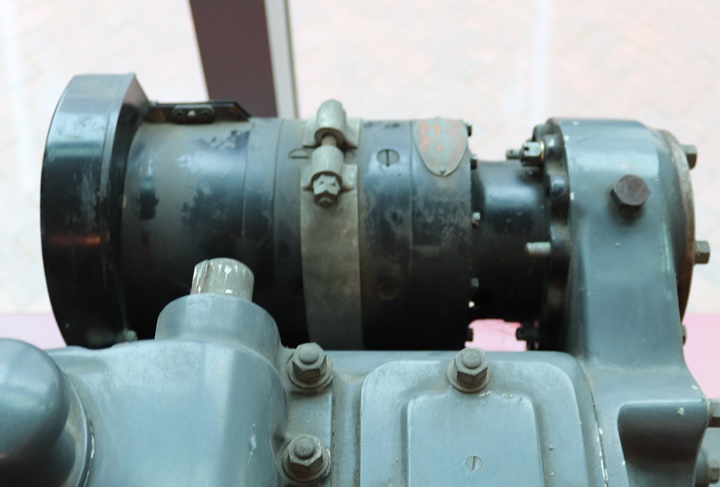
This
Delco-Remy DC generator is located on the opposite side of the Packard
engine. While not as easy to see, the D-R tag is still
identifiable. Author's photo added 3-29-2018.

One can actually see the Delco-Remy DC
generator on the Packard engine through the window. With all of
the reflections from the glass the generator is somewhat obscured, but
it and the D-R tag are identifiable as such. Author's photo added
3-29-2018.

This Packard Marine Engine still has its
Delco-Remy starter and generator installed. Author's photo
from the National Museum of the Pacific War in Fredericksburg, TX.

Author's
photo.

The D-R Tag from the DC generator.
Author's photo.

Delco-Remy starters
came on each of the 2,235 Packard marine engines installed in PT boats
during WWII. Author's photo.

Author's photo.

Author's photo.

This excellent restoration of a Packard
4M2500 marine engine is on display a Battleship Cove in Fall River, MA.
Author's photo added 4-23-2020.

Even though the engine and components have
been painted as protection from the salty air at the museum, the
distinctive D-R tag is still evident on the DC generator.
Author's photo added 4-23-2020.

Author's photo added 4-23-2020.

There is no visible D-R tag on the
Delco-Remy cranking motor. Author's photo added 4-23-2020.

The Wright Museum of World War Two in
Wolfeboro, NH has a Packard M2500 engine on display. Author's
photo added 4-23-2020.

The Delco-Remy cranking motor and D-R are
still on the motor. Author's photo added 4-23-2020.

Author's photo added 4-23-2020.

Author's photo added 4-23-2020.

The Delco-Remy generator and D-R tag are
still on the Packard 4M2500 marine engine. Author's photo added
4-23-2020.

Author's photo added 4-23-2020.
Hall-Scott Defender Marine Engine:
Hall-Scott of Berkeley, CA built 6,514 Defender Marine Engines that
were used in a variety of Motor Gun Boats and Rescue Boats during World
War Two. These engines had a Delco-Remy combination distributor and coil
unit, which was water-proof, and fungus and corrosion
resistant. The Delco-Remy part number was 1111597. Each
engine had two combination coil and distributor units. Delco-Remy
supplied 13,028 ignition units for OEM production plus spare parts.

The Hall-Scott 12-cylinder Defender marine
engine. Delco-Remy part number 1111597 can be seen in this photo.
Photo added 4-23-2020.

Defender Models 2268 and 2269 were
right-hand and left-hand drive engines, respectively. Photo added
4-23-2020.

The operator's manual shows Delco-Remy part
number 1111597. Interestingly enough, this is the only
manufacturer's part number specified in the manual. Photo added
4-23-2020.

This shows a cross-sectional view of
Delco-Remy part number 1111597. Photo added 4-23-2020.

This is the wiring diagram for the two
Delco-Remy 1111597 Ignition Assemblies on a Hall-Scott Defender Marine
Engine. Photo added 4-23-2020.
Table 2 - Hall-Scott Defender Engine usage in small boats during World
War Two
The totals of Table 2 and Table 3 below do not add up to the
total of 6,514 Defender Engines built by Hall-Scott during World
War Two. Some of the engines were spare parts, and some
applications may not be known. |
|
Type |
Number built |
Engines per boat |
Total engines |
Comments |
| U.S.
Army Aircraft Rescue boat |
|
|
|
See
Table Below. |
|
British and Canadian Navy Fairmile Patrol Boat Series |
|
|
|
|
|
Fairmile A M/L Patrol Boat (Motor Gun Boat) - UK |
12 |
3 |
36 |
British built for RN |
|
Fairmile B M/L Patrol Boat (Motor Gun Boat) - UK |
593 |
2 |
1,186 |
British built for RN |
|
Fairmile B M/L Patrol Boat (Motor Gun Boat) - Canada |
62 |
2 |
124 |
Canadian built for RCN |
|
Fairmile C M/L Patrol Boat (Motor Gun Boat) - UK |
24 |
3 |
72 |
British built for RN |
| U.S.
Coast Guard Patrol Boat |
? |
|
? |
It is
unknown which Coast Guard Patrol boat the Defender engine was
used in. |
| U.S.
and British Navy Rescue Boats |
|
|
|
See
Table Below. |
| U.S.
Army Aircraft Rescue Boat |
|
|
|
See
Table Below. |
| U.S.
Army Aircraft Rescue Boat 104-foot (P110-115 141-145) |
11 |
3 |
33 |
There
were 93 104-foot rescue boats built. The original series
had Kermath Sea Raider engines. The next series, known as
the 200 series, was powered by the Hall-Scott Defender.
Only 11 of the 104-foot boats have been verified to have been
built with the Defender. There were probably more in the
200 series but the historical record does not verify this. |
|
British Naval Torpedo Boat - 70-foot Vosper MTB |
22 |
3 |
66 |
These
were replaced in 1942 with three Packard 4M2500 engines. |
|
Totals |
724 |
|
1,517 |
|
Table 3 - Hall-Scott Defender-Powered 63-foot Rescue Boats
Below are all of applications for a Defender engine in this
rescue boat |
|
Model 63-Foot Rescue Boat |
Number built |
Number of Engines |
Total Engines |
Comments |
| 152 |
8 |
2 |
16 |
For
Great Britain. |
| 293 |
76 |
2 |
152 |
Subchaser version of the boat. Some went to Russia. |
| 314 |
352 |
2 |
704 |
The U.S.
Navy received 240 boats. Some boats went to the Netherlands and the
U.K. The U.S.C.G. received 29 and U.S. Army Air Force
received 54. Australia was given 20. The ones that went to
the Coast Guard became its standard 63-foot rescue boat for
World War Two and into the 1950s. |
| 416
or Type 3 |
79 |
2 |
158 |
These
were built to U.S. Army specifications. |
| Mark
2 |
16 |
2 |
32 |
|
| Mark
3 |
69 |
2 |
138 |
|
| Mark
4 |
9 |
2 |
18 |
|
|
Total |
609 |
|
1,218 |
|

Eleven 104-foot rescue boats were outfitted
with Hall-Scott Defender engines. A few had four Kermath Sea
Raider engines with Delco-Remy starters, DC generators, regulators,
coils and distributors. No matter which engine was used in the
boat, Delco-Remy electrical components were installed. This model
is on display at the National Museum of the United States Air Force.
Photo added 4-23-2020.
Hall-Scott / Hudson Motor Car Company
Invader Marine Engine:
Hall-Scott of Berkeley, CA built
1,692 Invader Marine Engines in 1942, which it designed several
years earlier. Due to lack of production capacity, the manufacture
of the Invader engine was then turned over to the Hudson Motor Car
Company which built another 4,000. All Invader engines had
Delco-Remy distributors, coils, voltage regulators, starters and DC
generators.
Table 4 - Invader Engine usage in small boats during World War
Two
Hall-Scott and Hudson produced 5,692 Invader engines during
World War Two. These
5,692 engines were used in the following applications.
Hall-Scott Invader engines, along with several other type engines,
were specified for the LCP(L), LCV and LCVP landing craft.
However, the U.S. Navy preferred diesel engines. So, the
Gray Marine/Detroit Diesel 6-71 engine became the standard
engine for these type landing craft. When there were
insufficient diesels to meet all of the needs of the military, because it
was used in Sherman tanks and Wolverine tank destroyers,
Hall-Scott/Hudson Invader and the other gasoline powered engines
were substituted.
As far as Delco-Remy was concerned, it didn't matter whether the
boats had Invader or 6-71s installed. Both had D-R
components.
The historical record is unclear on how many of the boats below
were equipped with the Invader engine. |
|
Type |
Number built with Invaders |
Engines per boat |
Total Engines |
Comments |
| LCV
(U.S. Navy Ramp Boat) 36-Foot |
? |
1 |
? |
The
Hall-Scott was one of the original engines specified for the LCV. |
| Coast
Guard 38-foot and 45-foot Picket boats |
? |
1 |
? |
There
were 500 of these built in 1942 and 1943. They used a
variety of engines including the Invader. |
| U.S.
Navy-Army 63-Foot Rescue Boat |
20 |
2 |
40 |
The U.S.
Army received six of these. |
| LCP(L)
(U.S. Navy Landing Boat) 36-Foot |
? |
1 |
? |
The
Hall-Scott was one of the original engines specified for the
LCP(L). |
| U.S.
Army 42-Foot Rescue Boat |
? |
2 |
? |
The
42-foot rescue boats were built with either Kermath Sea Raider
or Hall-Scott Invader engines. |
| LCP(R)
(Landing Craft, Personnel, Ramp) 36-Foot |
? |
1 |
? |
|
| LCVP
(Landing Craft, Personnel, Ramp) 36-Foot |
? |
1 |
? |
The
Hall-Scott was one of the original engines specified for the LCVP. |
| |
? |
|
5,692 |
Based on 1942 production |

A Hudson Invader marine engine comes off the
assembly line in Detroit during World War Two. Delco-Remy supplied the
electrical equipment for the 4,000 engines built. The Remy
starting motor and solenoid are visible in this photo. The voltage
regulator is the rectangular box to the right of the starter. It
would make sense for this to be a Remy unit. However, the name on
the regulator is Hudson Motor Car Company. It could be Delco-Remy
was under a contractual agreement to cast Hudson's name into the die
cast cover.

This contemporary photo of an Invader
engine was taken at the Ypsilanti Automotive Heritage Museum shows the
starter and solenoid. Note the upside down triangle in the voltage
regulator. Author's photo.

Author's photo.

The water-proof distributor is located on the left front
side of the engine. Author's photo.
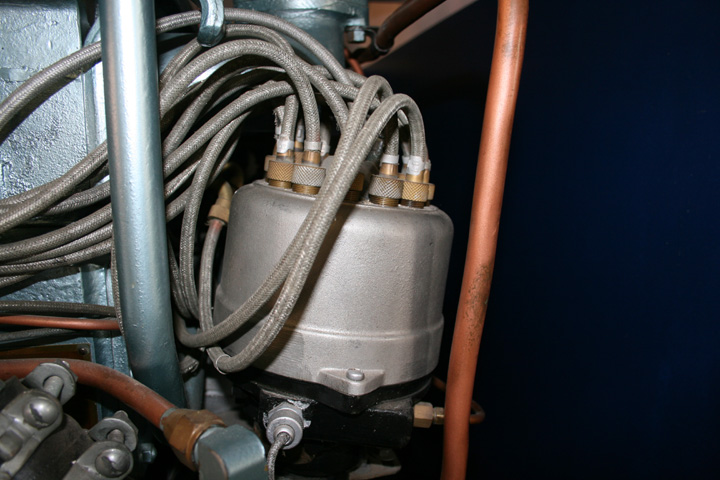
The Delco-Remy distributor on the Invader
engine is a marine type, to protect the internal parts from salt
corrosion. Author's photo.

Delco-Remy distributor model 4242, serial
number 8204. Author's photo.

The Remy DC generator is located below the
distributor. Author's photo.

The 42-foot rescue boat was powered by either a Hall-Scott Invader or
Kermath Sea Raider engine. In either case, Delco-Remy electrical
components were on board. Photo added 4-23-2020.

Photo addedxxxxxx
Kermath Sea-Raider 6 Marine Engine:

This page of the operator's manual shows
that the Kermath Sea Raider 6 engine was used in the 42-foot rescue boat.
Hall-Scott Invader is also specified as noted in the Invader section
above. Photo added 4-23-2020.
Kermath Sea-Raider Special 12 Cylinder Marine Engine: This
engine was used in a small number of 104-foot crash boats. Most
likely this was less than ten boats. Delco-Remy part numbers were:
Cranking Motor part number 000542, Voltage Regulator part number 5638,
DC Generator part number 1117304 for standard rotation and part number
1117305 for opposite rotation, Distributor part number 1111212, and
Ignition Coil part number 1115253.

Eleven 104-foot rescue boats were outfitted
with Hall-Scott Defender engines. A few had four Kermath Sea
Raider engines with Delco-Remy starters, DC generators, regulators,
coils and distributors. No matter which engine was used in the
boat, Delco-Remy electrical components were installed. This model
is on display at the National Museum of the United States Air Force.
Photo added 4-23-2020.

Photo added 4-23-2020.

Photo added 4-23-2020.
Gray Marine 64HN9/Detroit Diesel 6-71 Marine
Engine: This engine was the
marine version of the Detroit Diesel Division of General Motors 6-71
six-cylinder 225 h.p. engine. Detroit Diesel built up the engine,
tested it, and then shipped it to Gray Marine in Detroit. It then
added all of the necessary equipment for marine operation in landing
craft. This included but was not limited to adding a heat exchanger and
transmission. Because Gray was the last company to work on the
engine, it is normally known as the Gray Marine 64HN9. However,
because Detroit Diesel supplied the base engine, I make note of its
important contribution by denoting it as the Gray Marine 84HN9/Detroit
Diesel 6-71. Like the Packard 4M2500 marine engine, it was in high
demand with a limited supply, and was the preferred engine for American
landing craft during World War Two.
The table below summarizes the number of World
War Two landing craft built with Detroit Diesel Division of GM engines.
The 43,060 diesel powered landing craft were equipped with a total of
57,189 6-71 engines, each using a Remy starter, generator, voltage
regulator and supercharger blower. Delco-Remy
also cast pistons for Detroit Diesel, and they were used in the landing
craft engines.
|
Table 5 - Detroit Diesel
Engine World War Two Landing Craft Applications |
|
Type Landing Craft |
Number built |
Type Engine |
Engines per Landing Craft |
Landing Craft using Detroit Diesel Engines for propulsion |
Number of Detroit Diesel Engines for propulsion |
Number of 6-71 for ship's power |
6-71 Engines Usage |
Comments |
| LCP(L) |
2,193 |
Various including
Gray Marine 64HN9/Detroit Diesel 6-71 |
1 |
1,097 |
1,097 |
|
1,097 |
Assumes 50% Gray
Marine 64HN9/Detroit Diesel 6-71 as that was the preferred
engine. |
| LCP(R) |
2,572 |
Various including
Gray Marine 64HN9/Detroit Diesel 6-71 |
1 |
1,286 |
1,286 |
|
1,286
|
Assumes 50% Gray
Marine 64HN9/Detroit Diesel 6-71 as that was the preferred
engine. |
| LCV |
2,366 |
Various including
Gray Marine 64HN9/Detroit Diesel 6-71 |
1 |
1,183 |
1,183 |
|
1,183
|
Assumes 50% Gray
Marine 64HN9/Detroit Diesel 6-71 as that was the preferred
engine. |
| LCVP |
23,353 |
Gray Marine
64HN9/Detroit Diesel 6-71 or Hudson built Hall-Scott 210 hp
gasoline powered Invader |
1 |
19,353 |
19,353 |
|
19,353 |
Some LCVPs
received the Hudson built Hall-Scott 210 hp gasoline powered
Invader engines due to the fact Detroit Diesel could not supply
all of the engines the military was requesting. Hudson built
4,000 of these so I have used that number to subtract from
23,353. |
| LCM(3) |
8,631 |
Gray Marine
64HN9/Detroit Diesel 6-71 or
Kermanth 100 hp six cylinder gasoline engines |
2 |
4,223 |
8,446 |
|
8,446 |
Assumes 50% Gray
Marine 64HN9/Detroit Diesel 6-71 as that was the preferred
engine. |
| LCM(4) |
2,718 |
Gray Marine
64HN9/Detroit Diesel 6-71 or
Kermanth 100 hp six cylinder gasoline engines |
2 |
2,039 |
4,078 |
|
4,078 |
Assumes 75% Gray
Marine 64HN9/Detroit Diesel 6-71 as that was the preferred
engine. |
| LCM(6) |
2513 |
Gray Marine
64HN9/Detroit Diesel 6-71 or
Kermanth 100 hp six cylinder gasoline engines |
2 |
1,885 |
3,770 |
|
3,770 |
Assumes 75% Gray
Marine 64HN9/Detroit Diesel 6-71 as that was the preferred
engine. |
| LCT(5) |
470 |
Gray Marine 64HN9/Detroit Diesel 6-71 |
3 |
470 |
1,410 |
|
1,410 |
|
| LCT(6)
|
960 |
Gray Marine 64HN9/Detroit Diesel
6-71 |
3 |
960 |
2,880 |
|
2,880 |
|
| LCI |
923 |
Detroit Quad
Diesels (6051) |
2 |
923 |
1,846 |
1,846 |
9,230 |
The 6051 was the
designation for four 6-71s tied together. The ship's power on
the LCI was provided by two 6-71 engines driving 60KW
generators. |
| LCS(L) |
130 |
Detroit Quad
Diesels (6051) |
2 |
130 |
260 |
260 |
1,300 |
The ship's power
on the LCS(L) was provided by two 6-71 engines driving 60KW
generators. There is still on LCS(L) in existence at Mare
Island in San Francisco, CA. See the links page for more
information. |
| LST |
1,052 |
Detroit Diesel
6-71 |
3 |
1,052 |
0 |
3,156 |
3,156 |
The ship/s power
on the LST was provided by three 6-71 engines driving 100KW
generators. |
| Totals |
47,881 |
|
|
34,601 |
45,609 |
5,316 |
57,189 |
This does not
include any spares. Also, this is almost a year's production
for Detroit Diesel during the WWII. |
|
Type Landing Craft |
Number built |
Type Engine |
Engines per Landing Craft |
Landing Craft using Detroit Diesel Engines |
Number of Detroit Diesel Engines |
Number of 6-71 for ship's power |
6-71 Engines Usage |
Comments |

23,353 LCVPs were built in the United States
during World War Two by Higgins Industries, Chris-Craft and Owens Yacht. This LCVP, constructed by Owens Yacht, is owned by the Roberts Armory, a
private museum, in Rochelle, IL. It is one of 2,000 built by Owens
Yacht. Of the 23,353 originally built, it is one of only eighteen
still in existence. What makes this LCVP significant is that it
was one of the 19,353 that came equipped with a Detroit Diesel 6-71
engine. Charles Roberts, owner of Roberts Armory, has done a remarkable job
of restoring this all wooden vessel to the way it looked when it was
built in 1945. Author's
photo.

The Detroit Diesel 6-71 engine with the cast
blower visible. Delco-Remy assembled the blower at the Muncie
battery plant. Author's photo.

Here the Delco-Remy naval starter is visible. Photo courtesy of Chuck C. Roberts of the Roberts Armory.

Model 1108734. Photo courtesy of Chuck C. Roberts of the Roberts
Armory.
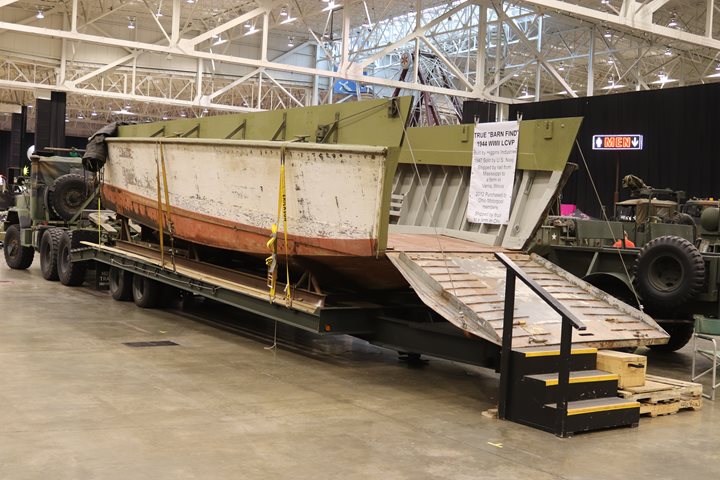
This LCVP was manufactured in 1944 by
Higgins. It was kept in a barn in Varna, IL until 2012, when
the Ohio Motorpool purchased it. It has not been restored but is
in the condition it was found. It is a true original example of
the famous "Higgins Boat." Author's photo from the 2017 MVPA
convention at the former Cleveland Tank Plant added 7-31-2017.
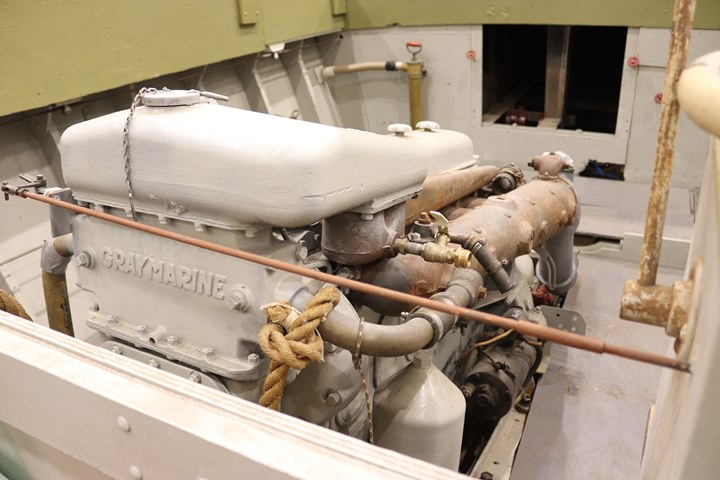
The Delco-Remy starter can be seen on the
engine. Author's photo from the 2017 MVPA convention at the former
Cleveland Tank Plant added 7-31-2017..

The DR tag is still on the starter, but no
longer readable with the rust on it. Author's photo from the 2017 MVPA
convention at the former Cleveland Tank Plant added 7-31-2017.
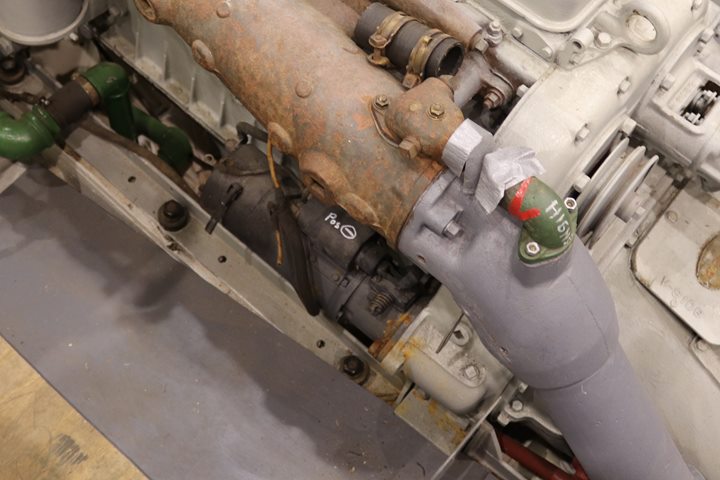
Author's photo from the 2017 MVPA convention at the former Cleveland
Tank Plant added 7-31-2017.
Cleveland Diesel Division of General Motors
Marine Engines:

The USS Cod on display along the Cleveland,
OH waterfront is of the Gato class submarines. The USS Coc was one of over 200 US submarines in the Gar, Gato, Baleo, and Trench
class of submarines powered by diesel engines built by the Cleveland
Diesel Division of General Motors. Delco-Remy
cast pistons ranging in size from 4 to 17 inches in diameter, used by Detroit
Diesel Division, Cleveland Diesel Division and Electro-Motive
Division engines for marine applications. Author's photo.

The USS Cod had four Cleveland Diesel engines. Two of them are
visible in this photo. Author's photo.

The USS Slater in Albany, NY has Cleveland
Diesel marine engines for both propulsion and ships power. Photo
added 4-23-2020.

Shown here are several parts for a Cleveland
Diesel engine inside the engine room of the USS Slater. Delco-Remy
made pistons like the one shown in the photo. Author's photo added
4-23-2020.
Electro-Motive Division of General Motors
Marine Engines:

525 of the 1,051 Landing Ships, Tanks, or LSTs
built during World War Two were powered by two Electro-Motive Model 12-567 900 h.p.
engines. Each LST with an Electro-Motive 12-567 engine had a
Delco-Remy Model 902(CW) or 903(CCW) cranking motor to start it.
For more on this subject please visit my page:
LST393

This is the size of the Delco-Remy 902
cranking motor compared to my size 9-1/2 shoe. Author's photo added
4-23-2020.
The LSTs with the Electro-Motive 12-567
propulsion engines also used three Detroit Diesel 6-71 engines to
provide for ship's power. These engines had Delco-Remy starters on these engines. Pistons for the two Electro-Motive
Division of GM propulsion engines were cast in DR plant 5.
Author's photo.

Electro-Motive Division of General Motors
produced 544 Pancake Diesel 16-cylinder 16-184A Electro-Motive 1,200 hp
for 243 110-Foot subchasers. The subchasers with the Electro-Motive
Pancake engines had Delco-Remy equipped propeller pitch controls.

A World War Two 110-foot subchaser.

A US Navy LCI(L) (Landing Ship, Infantry
(Large)) underway during WWII with Delco-Remy equipped propeller pitch
controls. 1,098 Landing Craft, Infantry (Large) were supplied with
Delco-Remy propeller pitch controls. Each LCI(L) had two engines
resulting in Delco-Remy providing at least 2,196 units for the war
effort.
Motor Torpedo Boat Engineer's Handbook: Below is a section of the Engineer's Handbook
on the PT boat. It contains several locations where the Navy
specified Delco-Remy components.



Delco-Remy supplied both 75 amp and 40 amp
28 volt DC generators for US Navy PT boats.

For the 75 amp generator, Delco-Remy supplied
a vibrating finger type voltage regulator; and for the 40 amp generator, a
carbon pile type regulator. The Division also supplied the
cranking motor.
|







































































